How to propagate barberry in spring, summer and autumn: cuttings, layering and seeds
Barberry is the real king of the autumn garden. Indeed, this shrub is able to amaze any gardener with its decorativeness and unpretentiousness. So what to do if you wanted to have such a wonderful plant on your site, but you don't want to buy an expensive seedling?
That's right, you need to multiply it, and first get seeds or cuttings, or ask your neighbor to divide his bush (or dig in the layers).
Well, it's time to talk about how to propagate barberry correctly, what methods exist, when it is necessary and can be done.
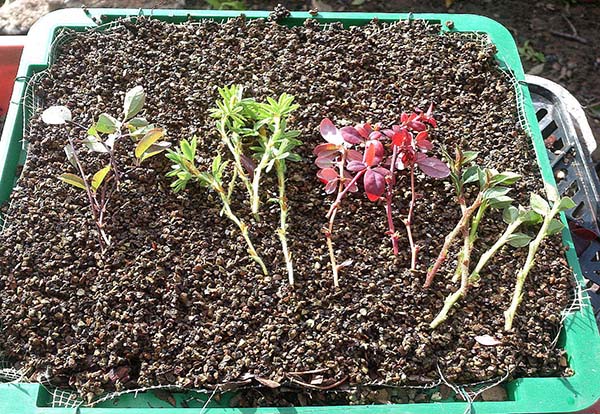
Content
How and when to propagate barberry: timing and methods
In principle, barberry can be propagated at any time of the year - even in spring, even in summer or autumn.
However, for each period, certain methods of breeding barberry are suitable:
- So, in the spring (in April-May) they are engaged in planting rooted cuttings and young seedlings, and also propagate by dividing the bush and digging in layers.
- In summer, cuttings are cut (in July-August), namely, green cuttings are cut and put on rooting.
It is very undesirable to divide barberry bushes in the summer in the heat (in July), because the plant may not take root due to high temperatures.
- In the fall (in September-October), lignified cuttings are divided and harvested for their further storage in winter and subsequent planting in the spring, and already rooted cuttings are planted in open ground and the rooted cuttings are separated.
Breeding methods for barberry
There are several ways of breeding barberry:
- seeds;
- cuttings;
- dividing the bush;
- layering.
In most cases, gardeners prefer to propagate barberry in one of the vegetative ways, because only in this case the new plants will be completely similar to their parents. With the seed (generative) method, they can turn out to be completely different: with a different shape, shade and pattern of leaves.
In order to decide which method of breeding barberry is best for you, we will further familiarize ourselves with each of them.

Seeds
As a rule, it is believed that the propagation of shrubs and trees by seeds (bones), i.e. in a generative way, it is very long and ineffective, because varietal traits when sown with seeds are most often not preserved. But not in the case of barberry!
Interesting! Of course, the properties are not preserved 100%, however, in general, new barberry seedlings for the most part repeat the maternal qualities. And the barberry grows fast enough. Therefore, the method is quite effective.
When and where to collect seeds?
At the end of autumn, you can collect seeds (i.e. berries) directly from the bushes of your favorite variety.
Of course, you can buy pre-packaged seeds.

How to plant barberry with seeds:
- Rinse the seeds from the pulp (if you decide to harvest the fruits yourself) and dry, and then store them until the end of winter or early spring.

- In February, place the seeds for artificial stratification (for example, sow on the sand and put in a closed container under the snow either in the basement / cellar or in the refrigerator, but first soak them in plain water for 2-3 days.
Alternatively, you can sow barberry seeds before winter. Then they will undergo natural stratification and will rise on their own in April-May. However, there is a good chance that the seeds will be eaten by mice.
- Further, in April, when the seeds are swollen or have already hatched, they are sown in a greenhouse or a little later immediately in open ground (for the first time).
But you can first in the pots.
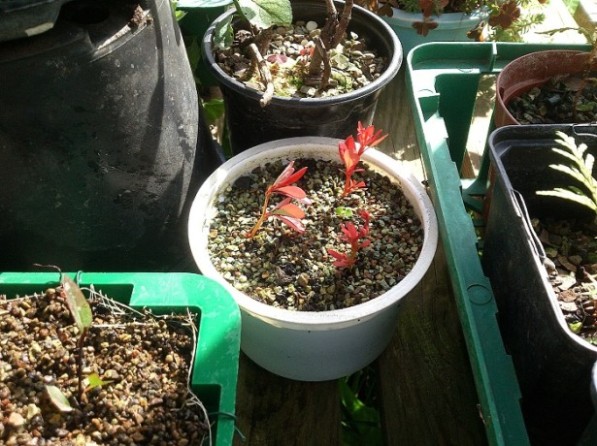
- In the fall, you can transplant seedlings from a greenhouse or containers to a permanent place in open ground.
Video: seed barberry
Cuttings
Of course, the main advantage of barberry cuttings is 100% preservation of varietal characteristics.
You can propagate barberry with both green and lignified cuttings. But the first method is often used, i.e. cuttings are cut in the summer, not in the fall.
Plant many cuttings at once - at least 5-6. The result will not be 100% anyway.
Green cuttings
Step-by-step instructions for breeding barberry with green cuttings:
- Green cuttings are harvested in the second half of June and early July.
You can use branches cut from summer pruning.
- To do this, take young one-year increments: break out cuttings with "heels" (but you can also do without "heels", just a 10 cm long stalk with 2-3 internodes or 4-5 growth buds, while making an oblique cut from below, and from above - straight ).
- Then the lower leaves are completely removed, leaving only a few upper ones (and it is better to leave half of each of them).
- To improve rooting, you can place the lower part of the cuttings in a solution of one of the root formation stimulants (Kornevin or Heteroauxin) for several hours (up to 12 hours) or dip it in a dry powder.
- Then the cuttings are placed in a glass of water for germination (in this case, only the lower part of the cuttings without leaves should be in the water).
Alternatively, you can root in a glass filled with sand or with earth and perlite, deepening the cuttings at an angle to half their length.
- Next, you need to put the glass in a warm place or make a greenhouse (cover with a film or bottle).
The optimum temperature for rooting barberry cuttings is +20 .. + 25 degrees.
Do not forget to periodically air and spray the cuttings.
- When, after a few weeks (1 month), the roots appear on the lower half of the cutting (when germinating in water, this will be visible, in a transparent glass with sand, too), it will be possible to plant the cutting immediately in the open ground under a greenhouse (bottle). But first, it is advisable to adapt the plant to new conditions, gradually removing the shelter and / or taking the container outside for several hours.
Note! You can plant rooted cuttings in open ground already in the fall (in September).
Video: cuttings of barberry
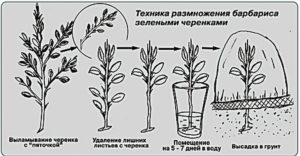
Lignified cuttings
Of course, you can try to cut the barberry in the fall (before the onset of frost), but it is not so easy to do this: you need to cut longer 15-20 cm cuttings, moreover, with a part of 2-year-old wood and save them until spring by digging in the garden in a trench or in wet sand in a cellar (basement), at 1 ... + 4 degrees.
It is very important that the cuttings do not dry out in winter.
And in the spring, transplant it into pots or directly to the garden bed and cover with a film or a glass / cut-off bottle (to make a greenhouse effect). Further, everything is the same as with green cuttings.
By dividing the bush
This is one of the easiest and most versatile ways to propagate any shrub.
However! It is necessary to divide the bushes for already mature plants that have grown enough. Otherwise, what will you actually divide?
- So, first you need to carefully dig out the mother bush itself, while minimally damaging the root system is very important.
- Next, you should divide the bush into several parts using a pruner (knife). Sections are sprinkled with ash or crushed activated carbon.
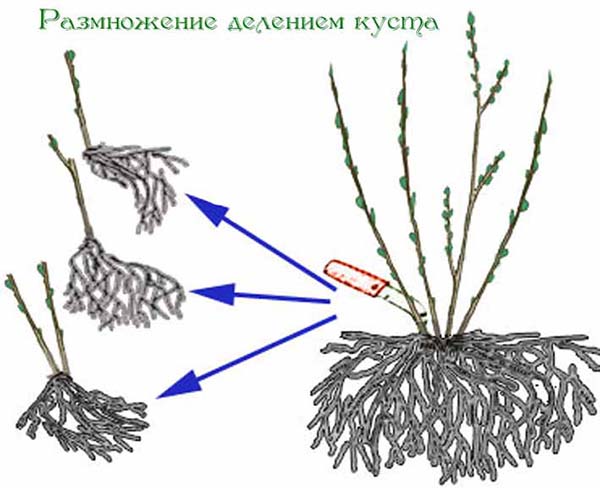
- Plant the resulting delenki-seedlings in the standard way.
Layers
Much less often, barberry is propagated by layering, but sometimes it turns out quite successfully.
Instructions:
- In the spring (April-May), dig a small trench (furrow) 5-8 cm deep.
- Bend down and tuck the long annual shoot into this groove.
- Fasten it on both sides (at the base and at the top) with a bracket or hook.
By the way! The top of the shoot must first be left above the soil surface, and then cut off to stop further shoot growth.
- Cover the shoot with earth on top (you can additionally put a brick in the place of the digging).
- Mulch (so that the earth does not dry out) and water thoroughly.
During the summer, do not forget to water periodically for better rooting.
- This fall or next spring, it will be necessary to separate the new plants from the mother plant and transplant to a permanent place.
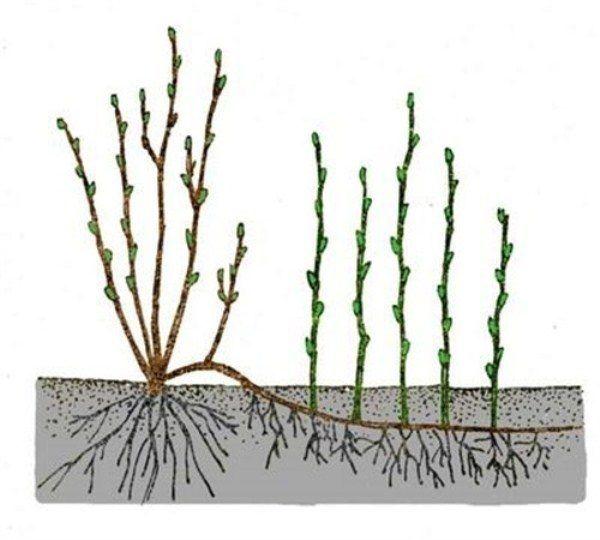
Thus, now you know that barberry can be propagated in several ways. The main thing is to remember that to obtain a shrub with maternal qualities, it is recommended to use vegetative propagation methods, although plants similar to their parents also very often grow from seeds. Good luck!
By the way! The site has detailed material about how to plant a barberry in your area (choose a suitable place - always sunny) and take care of it in the future.


